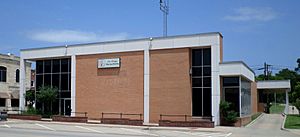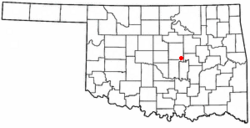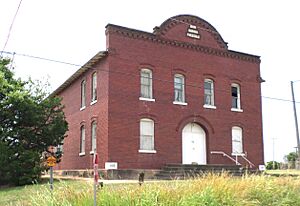Prague, Oklahoma facts for kids
Quick facts for kids
Prague, Oklahoma
|
|
|---|---|

Prague Municipal Building
|
|

Location of Prague, Oklahoma
|
|
| Country | United States |
| State | Oklahoma |
| County | Lincoln |
| Area | |
| • Total | 3.50 sq mi (9.05 km2) |
| • Land | 3.14 sq mi (8.13 km2) |
| • Water | 0.36 sq mi (0.93 km2) |
| Elevation | 948 ft (289 m) |
| Population
(2020)
|
|
| • Total | 2,356 |
| • Density | 750.80/sq mi (289.88/km2) |
| Time zone | UTC−6 (Central (CST)) |
| • Summer (DST) | UTC−5 (CDT) |
| ZIP Code |
74864
|
| Area code(s) | 405/572 |
| FIPS code | 40-60500 |
| GNIS feature ID | 2411483 |
Prague is a city in Lincoln County, Oklahoma, United States. It is pronounced "PRAYG". In 2020, about 2,356 people lived there. This was a small decrease from 2,388 people in 2010.
The city was started by immigrants from the Czech Republic. They named it after Prague, which is the capital city of the Czech Republic in Europe.
Contents
History of Prague
How Prague Was Founded
Czech immigrants settled in Prague after a "land run" on September 22, 1891. A land run was a way for people to claim land in new territories. Eva Barta owned the land where the town was built. She named the new town "Prague" after the capital city in Europe. At that time, Prague was part of a country called Austria-Hungary. The town officially became a city in 1902.
Important Events in Prague
On November 5, 2011, a series of earthquakes happened near Prague. The first one was a magnitude 4.7 earthquake. Later that day, a stronger one, magnitude 5.7, hit. This was the strongest earthquake ever recorded in Oklahoma at that time. Another 4.7 magnitude earthquake happened on November 7, 2011.
Prague also experienced a very strong tornado on May 5, 1960. It was an F5 tornado, which is the strongest type.
Geography
Where is Prague Located?
Prague is located in Oklahoma. Its exact coordinates are 35.486092 degrees North and -96.687792 degrees West.
Size of the City
According to the United States Census Bureau, the city covers a total area of about 1.8 square miles (4.7 square kilometers). All of this area is land.
Population Information
How Many People Live Here?
| Historical population | |||
|---|---|---|---|
| Census | Pop. | %± | |
| 1910 | 1,025 | — | |
| 1920 | 1,127 | 10.0% | |
| 1930 | 1,299 | 15.3% | |
| 1940 | 1,422 | 9.5% | |
| 1950 | 1,546 | 8.7% | |
| 1960 | 1,545 | −0.1% | |
| 1970 | 1,802 | 16.6% | |
| 1980 | 2,208 | 22.5% | |
| 1990 | 2,308 | 4.5% | |
| 2000 | 2,138 | −7.4% | |
| 2010 | 2,386 | 11.6% | |
| 2020 | 2,356 | −1.3% | |
| U.S. Decennial Census | |||
In 2000, there were 2,138 people living in Prague. These people lived in 864 households. About 567 of these were families.
Who Lives in Prague?
In 2000, most people in Prague were White (83.07%). There were also African American (3.70%) and Native American (9.92%) residents. A small number of people were Asian (0.33%) or from other backgrounds. About 1.12% of the population was Hispanic or Latino.
About 31.9% of households had children under 18 living with them. Many households (49.9%) were married couples. About 17.0% of households had someone aged 65 or older living alone.
The population was spread out by age. About 25.3% were under 18. About 19.4% were 65 or older. The average age in the city was 39 years old.
Local News

The Shawnee News Star and the Prague Times Herald are local newspapers. They provide news about Prague and the surrounding area. In the past, a Czech-language newspaper called Oklahomski Noviny was also printed in Prague.
Education
Prague Public Schools
The Prague Public Schools district serves the community. This school district teaches about 1,000 students.
Economy
How Prague Makes Money
When Prague was first settled, its economy mainly depended on farming. Corn was the most important crop. Farming is still important today. Over time, other businesses and industries also started to grow in Prague.
Transportation
Getting Around Prague
Prague is located where two main roads meet: U.S. Routes 377 and 62. It is also about 10 minutes north of Interstate 40, a major highway.
The city also has its own airport, the Prague Municipal Airport. It is located two miles west of town. The airport has a 3600-foot asphalt runway.
Culture
Czech Heritage and Festivals
Prague celebrates its Czech heritage. Every year, on the first Saturday of May, the city holds a 'Kolache Festival'. Kolaches are a type of sweet pastry. This festival celebrates the Czech culture that immigrants brought from their home country.
You can learn more about Prague's history and Czech culture at the Prague Historical Museum. It is located on the town's main street, Jim Thorpe Boulevard. This street is named after Jim Thorpe, a famous Olympic athlete. He was a member of the Sac and Fox Tribe.
Prague is also home to a special copy of the Infant Jesus of Prague. This copy is authorized by the Pope. It is known as the National Shrine of the Infant Jesus and many visitors come to see it each year.
Notable People
- Kyle Denney (born 1977), baseball player
- Walter E. Fountain (born 1961), United States Army officer
- Olinka Hrdy (1902–1987), artist
- Richard James (1926–2013), lawyer and legislator
- Orville Edwin Langley (1908–1973), U.S. District Judge for Eastern Oklahoma (1965-1973)
- Jim Thorpe (1887–1953), athlete, the first Native American Olympic gold medalist
Historic Places
National Register of Historic Places Sites
The following places in Prague are listed on the National Register of Historic Places. This means they are important historical sites:
- Prague City Hall and Jail
- ZCBJ Lodge No. 46, also known as Bohemian Hall
See also
 In Spanish: Prague (Oklahoma) para niños
In Spanish: Prague (Oklahoma) para niños

